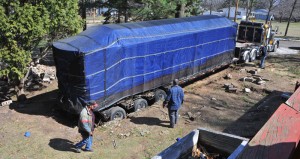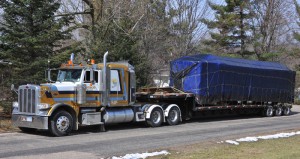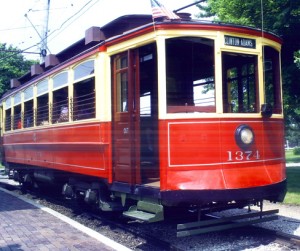First acquisition for new museum
By Angie Landsverk

The trolley discovered almost a year ago in a Weyauwega backyard is the first acquisition for a museum being developed in a Michigan community.
“I’m so glad it went to something like this. To have something preserved that’s about 110 years old is amazing. I could not see it being destroyed,” said Sharon Krapil.
Last June 2, Krapil and her husband, Bill, watched as the walls of the brown shack in their backyard were removed, revealing a former Chicago electric streetcar behind them.
The couple bought the home at 300 W. South St. in April 2014 and wanted more space in their backyard.
That is why they hired a construction crew to dismantle the shack.
On March 29, they watched as a semi pulled the trolley, covered in shrink wrap as it sat on a trailer, out of their backyard and onto the street for its eight-hour drive to Grass Lake, Michigan.
The trolley, which the Chicago Surface Lines operated around 1905, is now being refurbished for the Lost Railway Museum.
Interurban railway
“The interurban (railway system) was part of the fabric of the country back then,” said Jay Drouillard, who is involved in Grass Lake’s Lost Railway Museum organization.
The system ran within and between cities and villages in the early 1900s.
“They didn’t have automobiles. If they could jump on an interubran car and ride to their destination, that was pretty good,” he said.
This year, a group of people in this Michigan community decided to open such a museum in a historic building in the community, he said.
“We acquired a building and will start transforming it into a musuem later this year,” Drouillard said. “This is the first acquisition for the museum.”
The trolley, donated to the organization from the Krapils for $1, is a Chicago trolley car and never was used as an interurban, he said.
The Lost Railway Museum organization does have photographs of a trolley being used as an interurban to go to a nearby casino, Drouillard said.
“The photograph shows a car that was just like this. It is a sister car, part of a series,” he said. “We’re not going to pawn it (the Weyauwega trolley) off as an interurban. It’s a sister car. The only reason it still exists is because a structure was built around it.”
Most of those involved in the development of the new museum are retired, including Drouillard.
The group learned of the trolley and the Krapil’s desire to donate it to someone from Frank Sirinek, who for more than 50 years has been a volunteer at the Illinois Railway Museum, outside of Chicago.
That museum has a restored and operational trolley from the same series as the Krapil’s former trolley.
Trolley history

According to Sirinek, this type of car was the St. Louis Car Company’s first attempt, at the turn of the century, to manufacture a rubber stamp streetcar.
After 1908, other streetcar companies custom produced them on demand as cities ordered them.
The Chicago Surface Lines operated the electric streetcar from the 1100 series until about 1946, which is when cars like it became too small and slow for moving a lot of people, Sirinek said.
After World War II, the trolleys were sold to those wanting a place to live or stay, which is how they ended up throughout the Midwest, including in Weyauwega.
Sirinek became aware of the local trolley about 20 years ago, traveled to Weyauwega and took pictures of the structure built around it.
At that time, no one was living in it.
From about 1946 to 1948, the late Robert and Amanda (Mandy) Husberg lived in it with their three children – Amanda, Bob and William – before moving to Chicago.
News about the trolley being found behind the walls of the structure traveled to Brooklyn, New York, where Amanda saw a story about it on her local ABC newscast.
She recognized the brown siding and knew it was the trolley where she once lived after learning that it was found in the backyard of a small community in Wisconsin.
Last September, she stopped to see it on her way to visit family in the Plover area.
Both she and Krapil hoped a new home would be found for the trolley in Weyauwega, followed by its restoration.
“Weyauwega had a chance, but the city didn’t have the money,” Krapil said. “I was looking for any way to preserve it.”
Several others also expressed interest in it.

“In mid-March, we were contacted by the (Lost Railway) Museum. They said they wanted to come up and look at it,” she said.
Another person who had expressed interested in the trolley told the Krapils if someone wanted it, to give it away.
When representatives from the newly formed museum said they wanted the trolley, Krapil said she expected the move to take place in the summer.
“Then we got the call that they would be here March 28 to 29,” she said.
Sirinek also made the trip back to Weyauwega to watch the process.
A company that specializes in moving heavy items across the country accompanied members of the Lost Railway Museum organization.
“We’re going to restore it. We have a fantastic group of people involved,” Drouillard said. “The museum will be open by mid-year next year. This car will not be done by then.”
He said it will be restored for a static display.
“I’m so happy she’s going to be there with people who will respect her and take care of her,” Krapil said.
The Krapils look forward to visiting the museum in the future.
They have an open invitation to go there, as well as to the Illinois Railway Museum.
The couple plans to go to the Illinois museum this summer, where Sirinek told Krapil she “can even drive the trolley” and they will receive a personal tour.
Krapil said she is happy the trolley has a new home but also a bit sad.
When she looks out her kitchen window, she says, “It’s gone.”
However, she thinks about the many people she met because of the experience.
“They did a wonderful job,” she said.
Those involved in moving the trolley leveled off the backyard as best as they could and left grass seed for the Krapils to plant this spring.
Krapil called the trolley her “Grand Lady,” and said the story ended with a happy ending.
“It was an incredible journey with the trolley car, and I’ll treasure it for the rest of my life,” she said.
They wanted the trolley to be saved, appreciated and enjoyed by many.
“She’s gone to the right place, where she’ll get all of that and more,” she said.
